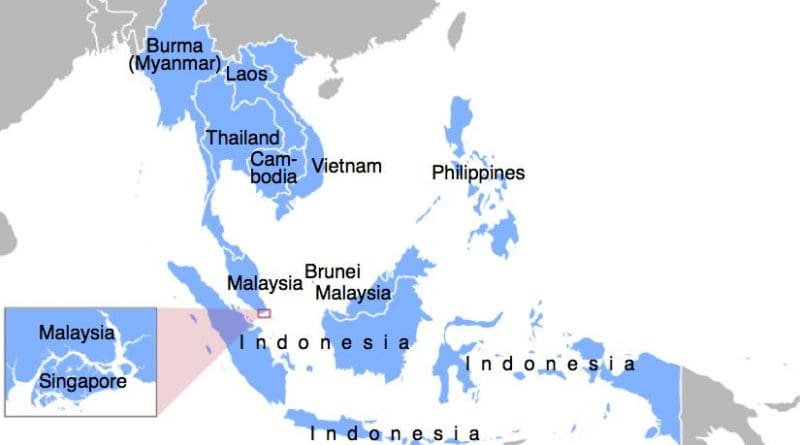ADMM-Plus At 10: Getting Regional Security Right – Analysis
By RSIS
The ADMM-Plus turns 10 at a time when the US-China rivalry is intensifying. With both superpowers initiating new, competing and exclusive regional visions and structures, ASEAN-centric platforms, especially the ADMM-Plus, are more relevant than ever before.
By Tan See Seng*
The ASEAN Defence Ministers Meeting-Plus (or ADMM-Plus) turns 10 next year. It was established on 2 October 2010 in Hanoi, Vietnam. In one mere decade, the ADMM-Plus has arguably achieved more in regional cooperation than older and more established multilateral platforms in the Asia-Pacific region. But its coming of age takes place at a time when the region is at risk of being destabilised by great power discord.
Geo-strategic rivalry between China and the United States has not only pressured ASEAN states to side with one or the other big power, but reshaped the contours and configuration of Asia-Pacific multilateralism. Nowhere is this more evident than in the formation by both superpowers of new competing regional visions and institutional architectures, such as the US-led Free and Open Indo-Pacific (FOIP) and the so-called “Quad” comprising Australia, India, Japan and the US, on the one hand, and China’s Belt and Road Initiative (BRI) on the other.
ASEAN as Superpower Battleground?
At times, the US-China rivalry has even threatened to turn multilateral arrangements like the ASEAN Regional Forum (ARF) into battlegrounds where the two superpowers trade barbs, jockey for influence and, in so doing, render regional cooperation nearly impossible. This happened at the 2010 ARF in Hanoi, where then China foreign minister Yang Jiechi and his US counterpart Hillary Clinton crossed swords over the South China Sea issue as a “core interest” for China and “national interest” for the US.
At the 2014 ARF in Naypyidaw, it was their respective successors Wang Yi’s and John Kerry’s turn to quibble over China’s building and militarising of islands in the South China Sea. More recently, at the 2018 APEC summit in Port Moresby, the clash between the two superpowers contributed directly to the summit’s failure to deliver a joint communique, for the first time in its history.
Yet all this in no way makes ASEAN-centric arrangements any less relevant. Quite the contrary, they assume even greater importance at a time such as this because the ASEAN-based groupings remain the platforms in town of which both the US and China are members and regular participants.
Despite claims by their respective architects that both the FOIP and the BRI are open and inclusive by design, the reality is that US-China rivalry has effectively turned those arrangements into exclusive platforms in practice: China is neither part of the FOIP nor a member of the Quad, whereas the US is not involved in the BRI. In place of those contesting visions and architectures, ASEAN-based arrangements are the only multilateral places that bring the two superpowers together.
ASEAN’s Stewardship: ‘Workshop’, not ‘Talkshop’
Nowhere is ASEAN’s continued relevance to US-China ties more evident than in its stewardship of the ADMM-Plus. The membership of the ADMM-Plus includes the US and China, the 10 ASEAN member states and six other regional countries (Australia, India, Japan, New Zealand, Russia and South Korea). In just one decade, the ADMM-Plus has gained a reputation for going where other Asia-Pacific arrangements have feared to tread.
Not just a “talk shop”, the ADMM-Plus has become a veritable “workshop” for cooperation in maritime security, humanitarian assistance and disaster relief (HADR), counterterrorism and other areas, involving the armed forces of all 18 of the ADMM-Plus member states. Indeed, the fact that both China and the US insisted on conducting maritime exercises with ASEAN ─ China in 2018 and the US in 2019 ─ underscores the importance both superpowers place on their respective ties with ASEAN.
The present zeitgeist of rising nationalism, nativism and protectionism has not been kind to multilateralism worldwide. In their own ways, both the US and China have hurt Asia-Pacific multilateralism. US President Donald Trump’s distaste for and dismissal of multilateral institutions is well known, while the trade war he precipitated against China (and other countries) has all but undermined trade multilateralism.
China President Xi Jinping has said all the right things in support of globalisation and economic liberalisation, but Beijing’s aggressive conduct in the South China Sea has threatened to divide ASEAN.
For all their Flaws…
Strategic competition among big powers is a normal, but uncomfortable, feature of international life. Where the US-China rivalry is concerned, what is worrisome is the tendency of both to talk at and act against one another ─ and forming new constructs and architectures that exclude one another ─ but not with each other. Without opportunities for meaningful dialogue, misunderstandings, disagreements and tensions are more likely than not to escalate.
For all their flaws, the ASEAN-centric platforms provide the US and China places to meet and opportunities for bilateral dialogue. Moreover, the multilateral setting of the ASEAN-based platforms also furnishes opportunities for the US and China to hear the views and concerns of other regional countries who have to live with the ramifications of their unremitting rivalry.
As the region’s premier platform through which the world’s great powers and Asia-Pacific countries engage in military exercises and potentially joint operations that contribute to the region’s well-being, the ADMM-Plus could well become a regional actor of consequence.
Over the years, Asia-Pacific multilateralism under ASEAN’s stewardship has been dismissed by critics as long on potential and promise, but short on realisation. In bringing the US and China together for meaningful dialogue and collaboration, the ADMM-Plus and other ASEAN-centric arrangements take a step closer to getting regional security right.
*Tan See Seng is Professor of International Relations at the S. Rajaratnam School of International Studies (RSIS), Nanyang Technological University (NTU), Singapore.

